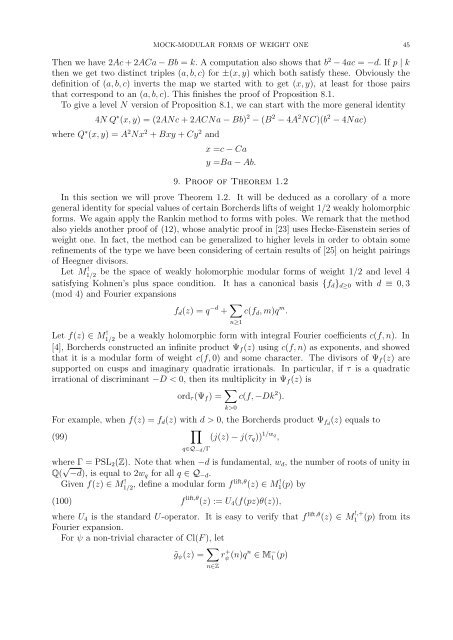Mock-modular forms of weight one - UCLA Department of Mathematics
Mock-modular forms of weight one - UCLA Department of Mathematics
Mock-modular forms of weight one - UCLA Department of Mathematics
You also want an ePaper? Increase the reach of your titles
YUMPU automatically turns print PDFs into web optimized ePapers that Google loves.
MOCK-MODULAR FORMS OF WEIGHT ONE 45<br />
Then we have 2Ac + 2ACa − Bb = k. A computation also shows that b 2 − 4ac = −d. If p | k<br />
then we get two distinct triples (a, b, c) for ±(x, y) which both satisfy these. Obviously the<br />
definition <strong>of</strong> (a, b, c) inverts the map we started with to get (x, y), at least for those pairs<br />
that correspond to an (a, b, c). This finishes the pro<strong>of</strong> <strong>of</strong> Proposition 8.1.<br />
To give a level N version <strong>of</strong> Proposition 8.1, we can start with the more general identity<br />
4N Q ∗ (x, y) = (2ANc + 2ACNa − Bb) 2 − (B 2 − 4A 2 NC)(b 2 − 4Nac)<br />
where Q ∗ (x, y) = A 2 Nx 2 + Bxy + Cy 2 and<br />
x =c − Ca<br />
y =Ba − Ab.<br />
9. Pro<strong>of</strong> <strong>of</strong> Theorem 1.2<br />
In this section we will prove Theorem 1.2. It will be deduced as a corollary <strong>of</strong> a more<br />
general identity for special values <strong>of</strong> certain Borcherds lifts <strong>of</strong> <strong>weight</strong> 1/2 weakly holomorphic<br />
<strong>forms</strong>. We again apply the Rankin method to <strong>forms</strong> with poles. We remark that the method<br />
also yields another pro<strong>of</strong> <strong>of</strong> (12), whose analytic pro<strong>of</strong> in [23] uses Hecke-Eisenstein series <strong>of</strong><br />
<strong>weight</strong> <strong>one</strong>. In fact, the method can be generalized to higher levels in order to obtain some<br />
refinements <strong>of</strong> the type we have been considering <strong>of</strong> certain results <strong>of</strong> [25] on height pairings<br />
<strong>of</strong> Heegner divisors.<br />
Let M<br />
1/2 ! be the space <strong>of</strong> weakly holomorphic <strong>modular</strong> <strong>forms</strong> <strong>of</strong> <strong>weight</strong> 1/2 and level 4<br />
satisfying Kohnen’s plus space condition. It has a canonical basis {f d } d≥0 with d ≡ 0, 3<br />
(mod 4) and Fourier expansions<br />
f d (z) = q −d + ∑ n≥1<br />
c(f d , m)q m .<br />
Let f(z) ∈ M<br />
1/2 ! be a weakly holomorphic form with integral Fourier coefficients c(f, n). In<br />
[4], Borcherds constructed an infinite product Ψ f (z) using c(f, n) as exp<strong>one</strong>nts, and showed<br />
that it is a <strong>modular</strong> form <strong>of</strong> <strong>weight</strong> c(f, 0) and some character. The divisors <strong>of</strong> Ψ f (z) are<br />
supported on cusps and imaginary quadratic irrationals. In particular, if τ is a quadratic<br />
irrational <strong>of</strong> discriminant −D < 0, then its multiplicity in Ψ f (z) is<br />
ord τ (Ψ f ) = ∑ k>0<br />
c(f, −Dk 2 ).<br />
For example, when f(z) = f d (z) with d > 0, the Borcherds product Ψ fd (z) equals to<br />
∏<br />
(99)<br />
(j(z) − j(τ q )) 1/wq ,<br />
q∈Q −d /Γ<br />
where Γ = PSL 2 (Z). Note that when −d is fundamental, w d , the number <strong>of</strong> roots <strong>of</strong> unity in<br />
Q( √ −d), is equal to 2w q for all q ∈ Q −d .<br />
Given f(z) ∈ M ! 1/2 , define a <strong>modular</strong> form f lift,θ (z) ∈ M ! 1(p) by<br />
(100) f lift,θ (z) := U 4 (f(pz)θ(z)),<br />
where U 4 is the standard U-operator. It is easy to verify that f lift,θ (z) ∈ M !,+<br />
1 (p) from its<br />
Fourier expansion.<br />
For ψ a non-trivial character <strong>of</strong> Cl(F ), let<br />
˜g ψ (z) = ∑ n∈Z<br />
r + ψ (n)qn ∈ M − 1 (p)
















